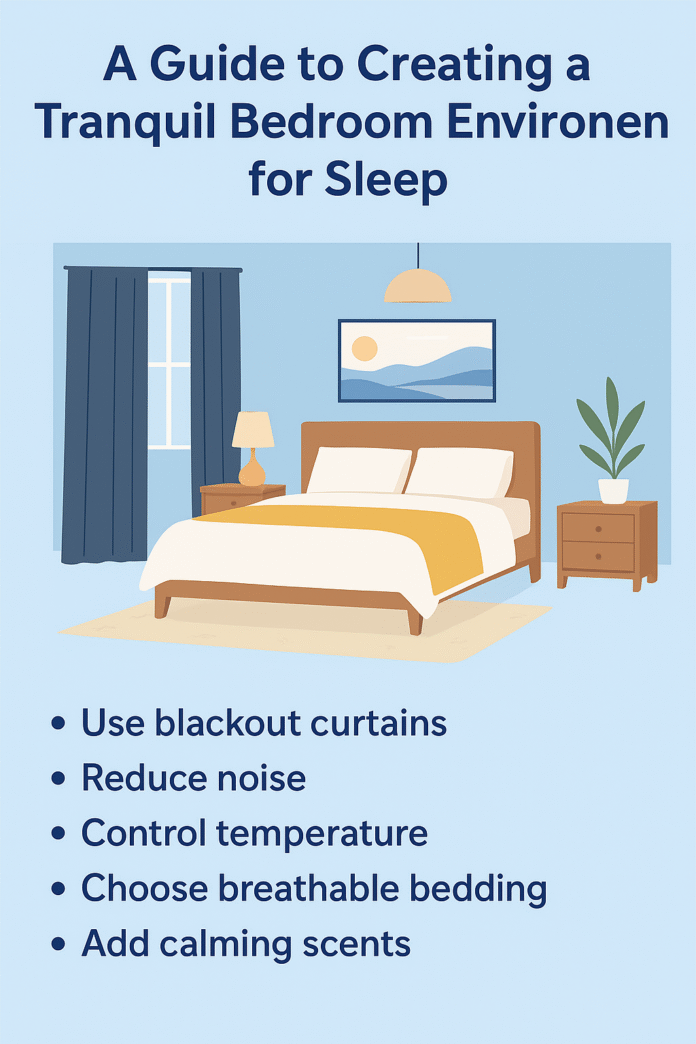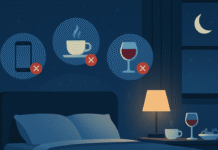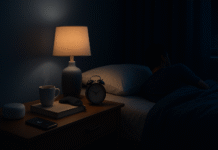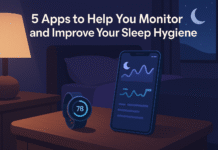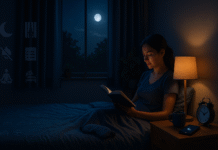A calm, well-designed bedroom does more than look nice — it guides your body and brain into the state they need for deep, restorative sleep. A Guide to Creating a Tranquil Bedroom Environment for Sleep will walk you through every part of that transformation: light, sound, temperature, bedding, air quality, layout, and simple rituals you can install immediately. This article is for busy people, parents, shift workers, students, light sleepers, and anyone who wants practical, research-informed steps to sleep better without hauling out a renovation budget.
Disclaimer: This article provides general sleep-environment advice. If you have persistent sleep problems, a diagnosed sleep disorder, or medical concerns, consult a qualified healthcare or sleep specialist for personalized guidance.
Key takeaways
- Control the basics first: light, sound, and temperature are the highest-impact levers for better sleep.
- Small, low-cost changes work: eye masks, blackout liners, a fan, and a weekly bedding routine can change sleep quality quickly.
- Design for consistency: consistent cues (dim light, stable temperature, same pre-bed ritual) train your brain to fall asleep faster.
- Measure and adjust: track time-to-sleep, awakenings, and morning alertness; tweak one variable at a time.
- Build gradually: use the 4-week starter plan to make changes stick without overwhelm.
Introduction — why the bedroom matters and what you’ll learn
Your bedroom is an environmental cue. The combination of dim light, soft textures, a cool room, low noise, clean air, and calming visual space signals to your nervous system that it’s time to downshift. This guide teaches you how to design that signal: which elements to prioritize, step-by-step set-up instructions, low-cost options, how to scale improvements, safety checks, a troubleshooting guide, and a 4-week action plan you can follow.
You’ll learn:
- Which environmental factors most reliably improve sleep.
- Exact, beginner-friendly implementation steps and cheap alternatives.
- How to measure improvement and what to watch for.
- A practical 4-week starter roadmap and an ongoing maintenance checklist.
Read on for fully practical, field-tested tips that you can implement tonight.
Light: shaping darkness and warm evening light
What it is and core benefits
Light — the amount, color, and timing — directly influences your circadian rhythm and the hormone signals that make you sleepy or awake. Dim, warm light in the evening and minimal light while sleeping make it easier to fall asleep and stay asleep.
Requirements / prerequisites and low-cost alternatives
- Preferred equipment: blackout curtains or lined shades; lamps with warm bulbs; dimmer switch or smart bulbs.
- Low-cost alternatives: thick curtains or blackout liners, a sleep mask, amber-tinted reading glasses, and low-cost warm bulbs or night-lights.
Step-by-step implementation (beginner-friendly)
- Block external light: install blackout liners or heavy curtains that cover the entire window frame. If you rent, use tension rods plus blackout liners or adhesive blackout film.
- Switch to warm evening light: replace overhead white/blue bulbs with warm (2700K or lower) bulbs. Put low-watt bedside lamps on a dimmer or use a plug-in smart bulb you can schedule.
- Use progressive dimming: 60–90 minutes before bed, lower the lights and the screen brightness in your home. Avoid bright screens 30–60 minutes before lights-out.
- Reserve lights in the night: keep a small, soft night-light or a warm lamp on a timer for middle-of-the-night bathroom trips, instead of overhead bright lights.
- Use an eye mask if blackout is incomplete.
Beginner modifications & progressions
- Simplify: start with an eye mask and a single warm bedside lamp.
- Progress: add blackout curtains, smart bulbs, and a programmed lighting schedule that gradually dims each evening.
Recommended frequency/duration/metrics
- Dim lights for at least 60 minutes before bedtime.
- Keep your bedroom as dark as possible throughout the sleep period.
- Track time-to-sleep as your primary KPI; expect measurable improvement within 1–2 weeks.
Safety, caveats, and common mistakes
- Don’t create trip hazards when moving in the dark.
- Avoid overly bright “night” lights with cool / blue tones — they counteract the dimming effect.
- Don’t rely only on filters or “night mode” on devices; the timing and intensity of light still matter.
Mini-plan (2–3 steps)
- Install a blackout liner or drape this weekend.
- Replace overhead bulbs with warm bulbs and set a 60-minute dimming routine.
Sound management: reduce disruptions, add gentle masking
What it is and core benefits
Sound is a powerful trigger for arousal. Reducing intermittent or loud noises reduces awakenings. Gentle constant sounds can mask disruptive noises and sometimes speed sleep onset.
Requirements / prerequisites and low-cost alternatives
- Preferred equipment: white/pink/brown noise machine with adjustable volume and timer.
- Low-cost alternatives: fan, inexpensive Bluetooth speaker with looped ambient tracks, smartphone apps (set to airplane mode and on speaker).
Step-by-step implementation
- Identify major noise sources (street, HVAC, neighbors) and note when they occur.
- Try masking first: run a white or pink noise source at a low, steady volume starting at bedtime.
- Soundproof basics: use thick curtains, add a rug, put draft strips under doors, and place felt pads under noisy furniture.
- Test and tune: experiment with sound type (white vs pink vs natural sounds) for several nights to see which helps you most.
Beginner modifications & progressions
- Simplify: start with a fan or white-noise app.
- Progress: invest in a high-quality sound machine, soundproofing panels, or a window insert if noise is severe.
Recommended frequency/duration/metrics
- Run masking sound for the entire sleep period if it helps; or at least for the first 60–90 minutes.
- Track awakening count and subjective sleep continuity as metrics.
Safety, caveats, and common mistakes
- Avoid earbud/headphone use in bed for long stretches (safety and ear health).
- Keep volume at comfortable, non-startling levels. If you have hearing loss or tinnitus, check with a clinician about masking strategies.
Mini-plan (2–3 steps)
- Start a white-noise track at bedtime tonight at a low volume.
- Add a rug and draft strip to reduce external sounds in the next week.
Temperature & airflow: cool, steady, and breathable
What it is and core benefits
A cool, stable room temperature helps your body perform the natural nighttime drop in core temperature. Correct airflow prevents stuffiness and helps comfort, reducing nighttime awakenings.
Requirements / prerequisites and low-cost alternatives
- Preferred equipment: thermostat ideally set to a cooler range; fan or air conditioner as needed; breathable bedding.
- Low-cost alternatives: stand fan, window open (weather-dependent), thermal-regulating sheets.
Step-by-step implementation
- Set an initial target in the cooler range (a typical target for many is around the mid-60s F / ~18°C).
- Use layered bedding: base sheet + light blanket + duvet/comforter to add/remove layers without disrupting sleep.
- Introduce airflow: use a low-speed fan for airflow and white-noise masking. Open a window if safe.
- Use quick fixes: ice packs in a breathable cover or cooling pillow cases for hot nights.
Beginner modifications & progressions
- Simplify: add a fan and switch to lighter sheets.
- Progression: install a programmable thermostat to lower temperature automatically before your bedtime.
Recommended frequency/duration/metrics
- Keep a consistent temperature every night.
- Use sleep efficiency and the number of night wakings as key metrics.
Safety, caveats, and common mistakes
- Avoid extreme cold for infants and some older adults; check individual comfort.
- Ensure adequate ventilation; avoid trapping mold or high humidity by using proper airflow.
Mini-plan (2–3 steps)
- Lower thermostat or set fan tonight; test how you feel after two nights.
- Swap to breathable sheets the same week.
Bedding, mattress, and pillows: support, temperature, and cleanliness
What it is and core benefits
A supportive mattress and comfortable pillow align your spine and reduce pressure points. Breathable bedding regulates body temperature. Clean bedding reduces allergens that can fragment sleep.
Requirements / prerequisites and low-cost alternatives
- Preferred: a mattress that provides proper support and a pillow suited to your sleep position; natural/ breathable sheets.
- Low-cost alternatives: mattress topper to add support/softness; switching to cotton or linen sheets; inexpensive pillow swaps.
Step-by-step implementation
- Evaluate your mattress: test for sags, discomfort, creaks, or increased morning aches.
- Add or replace: use a mattress topper if replacing the mattress isn’t feasible. Rotate or flip per manufacturer instructions.
- Pick the right pillow: side sleepers often need a thicker, firmer pillow; back sleepers a medium loft; stomach sleepers a thin pillow.
- Upgrade sheets: choose breathable, natural fibers and change them on a schedule.
- Set a wash routine: wash sheets and pillowcases at least every two weeks; weekly if you sweat, have allergies, or sleep with pets.
Beginner modifications & progressions
- Simplify: start with a new set of breathable sheets and a pillow adjustment.
- Progress: add a mattress topper or replace the mattress when symptoms (sagging, persistent discomfort) persist.
Recommended frequency/duration/metrics
- Wash bedding: weekly to biweekly depending on sweat/allergies. Monitor allergy symptoms and morning freshness.
- Replace mattress: most mattresses show signs of decline around 6–10 years; base decisions on comfort, visible wear, and sleep quality.
Safety, caveats, and common mistakes
- Don’t buy a mattress solely from online reviews — test in person if possible.
- Avoid heavy quilts that cause overheating for warm sleepers.
- Use mattress covers if allergic to dust mites but ensure they’re breathable.
Mini-plan (2–3 steps)
- Change to breathable sheets and wash them this week.
- Add a mattress topper if your mattress feels too soft or uneven.
Air quality and humidity: keep the air clean and comfortable
What it is and core benefits
Indoor air quality and humidity affect breathing, allergy symptoms, and general comfort. Balanced humidity reduces dry air irritation and discourages dust mites and mold.
Requirements / prerequisites and low-cost alternatives
- Preferred: a room hygrometer, ventilation, and a dehumidifier or humidifier as needed.
- Low-cost alternatives: open windows when outdoor air quality permits; fans for airflow; a cheap hygrometer to monitor humidity.
Step-by-step implementation
- Measure humidity: buy a small hygrometer and note levels at night and morning.
- Set target range: keep relative humidity between roughly 30–50% to minimize mold/dust mite growth and dryness.
- Control moisture: run bathroom and kitchen exhaust fans; fix leaks and reduce in-room plants if humidity is high.
- Filter the air: use a HEPA-capable portable air cleaner if allergies are an issue.
Beginner modifications & progressions
- Simplify: buy a hygrometer and monitor for one week.
- Progress: add a humidifier or dehumidifier with a built-in humidistat set to your target range.
Recommended frequency/duration/metrics
- Continuously monitor; adjust humidifier/dehumidifier settings nightly if needed.
- Track nighttime congestion, waking with dry mouth, or condensation on windows as metrics.
Safety, caveats, and common mistakes
- Avoid letting humidifiers foster mold — clean them per manufacturer directions.
- Don’t over-humidify; keeping humidity above ~60% can encourage mold growth.
Mini-plan (2–3 steps)
- Buy a small hygrometer and record humidity for one week.
- If humidity is high, run exhaust fans; if low, use a humidifier on a tested schedule.
Electronics and blue light: reduce evening stimulation
What it is and core benefits
Screens emit short-wavelength light that can suppress sleepiness signals. Reducing evening screen exposure helps melatonin rhythm and sleep onset.
Requirements / prerequisites and low-cost alternatives
- Preferred: set devices to night mode; install blue-light reducing software; use a “no-screen” period.
- Low-cost alternatives: glasses that reduce blue light, keeping devices out of the bedroom, or using physical timers to power down devices.
Step-by-step implementation
- Set screen curfew: aim to stop screen use 60–90 minutes before your planned bedtime.
- Use night modes: if you must use screens, enable their night-shift or blue-light filter and reduce brightness.
- Move tech out of the bedroom: ideally keep phones and laptops on a charging station outside the bedroom.
- Replace screen time with low-stimulation activities: reading a print book, gentle stretching, or a warm beverage ritual.
Beginner modifications & progressions
- Simplify: try a 30-minute nightly screen gap to start.
- Progress: remove screens entirely 90 minutes before bed and charge them outside your room.
Recommended frequency/duration/metrics
- Keep nightly screen reduction as a consistent habit every night.
- Track sleep latency and perceived sleep quality to evaluate impact.
Safety, caveats, and common mistakes
- Blue-light blocking glasses vary widely in effectiveness; behavioral changes usually matter more.
- Avoid using device blue-light filters as an excuse to stay engaged on social apps.
Mini-plan (2–3 steps)
- Use night-mode and reduce device brightness tonight.
- Move phone to another room when you go to bed for two nights and note changes.
Color, decor and visual calm: design a soothing visual field
What it is and core benefits
Color tones, clutter, and decor complexity affect arousal and stress. A visually calm bedroom reduces rumination and speeds mental relaxation.
Requirements / prerequisites and low-cost alternatives
- Preferred: soft, muted colors for walls and textiles; minimal bedside clutter; purposeful art.
- Low-cost alternatives: change cushion covers, swap bright throw rugs for neutral tones, remove small visual clutter.
Step-by-step implementation
- Declutter surfaces: clear bedside tables and floors around the bed.
- Choose calm accents: swap bold patterns for muted tones, and avoid busy prints over the bed.
- Limit visual devices: hide chargers, cables, and office items out of sight.
- Create a dedicated “sleep zone”: keep work, exercise equipment, and TV out of the immediate sightline.
Beginner modifications & progressions
- Simplify: remove or box up three non-essential items tonight.
- Progress: repaint or add a single tonal textile element (drape, rug, headboard) if you want a deeper change.
Recommended frequency/duration/metrics
- Perform a weekly 5–10 minute tidy routine; if you share space, do a short evening reset ritual together.
- Track nighttime rumination and time-to-sleep after decluttering steps.
Safety, caveats, and common mistakes
- Don’t create sterile environments that feel impersonal; include a small comforting object if it helps you relax.
- Overly dark walls can make small rooms feel oppressive; balance darkness with warm lighting.
Mini-plan (2–3 steps)
- Clear all non-essentials from bedside surfaces tonight.
- Box three items that cause visual stress and store them elsewhere.
Scent and tactile cues: gentle smells and textures to cue sleep
What it is and core benefits
Certain scents and textures (soft blankets, smooth sheets) trigger relaxation by association. Short, moderate scent exposures and comfortable textures help the brain wind down.
Requirements / alternatives
- Preferred: dilute essential oil diffusers with timed settings and breathable, soft textiles.
- Alternatives: small lavender sachets in pillowcases, gentle fabric sprays, or a warm flannel cloth.
Step-by-step implementation
- Select a subtle scent: lavender is commonly used and supported by studies for improving sleep quality in many people.
- Time the scent: run a diffuser for 15–30 minutes before bed, then turn it off during sleep to avoid overexposure.
- Layer textures: choose sheets and blankets that match your thermal needs and are pleasant to the touch.
- Test for sensitivity: use a small trial dose to test for allergies or sensitivity.
Beginner modifications & progressions
- Simplify: place a lavender sachet in your pillowcase for short-term use.
- Progress: add a timed diffuser set to switch off after 20–30 minutes.
Recommended frequency/duration/metrics
- Use scent cues nightly or when you need help signaling wind-down.
- Track subjective sleep quality and morning refreshment.
Safety, caveats, and common mistakes
- Avoid scented products that you are sensitive to; test small amounts first.
- Keep candles away from textiles and never leave open flames unattended — use flameless options when possible.
Mini-plan (2–3 steps)
- Put a lavender sachet under your pillow tonight.
- If tolerated, invest in a small diffuser with a timer next week.
Layout, ergonomics, and sleep psychology: the non-technical finishing touches
What it is and core benefits
Where your bed sits relative to doors, windows, and light sources, and whether the bedroom is used for multiple activities, shapes sleep associations. A consistent “sleep ritual” paired with optimized layout strengthens sleep conditioning.
Requirements / alternatives
- Preferred: bed placed so that it’s not directly aligned with the door, minimal electronics within sight, and a small, repeatable pre-sleep routine.
- Alternatives: reposition the bed a few inches or rotate accessories to reduce visual clutter.
Step-by-step implementation
- Create a sleep-only zone: move work-related items out of sight and out of the room if possible.
- Arrange the bed for comfort: ensure a clear path to the bathroom and minimal direct light on your face from streetlights or devices.
- Develop a short wind-down routine: 20–30 minutes of low-stimulation activities (gentle stretching, journaling, reading a physical book).
- Use anchor cues: put a favorite relaxing object on your bedside table to remind your brain it’s sleep time.
Beginner modifications & progressions
- Simplify: tonight, put devices in a drawer and do five minutes of light stretching before bed.
- Progress: create a 20–30 minute fixed pre-sleep routine and follow it nightly.
Recommended frequency/duration/metrics
- Practice the wind-down routine each night. Track sleep latency, sleep quality, and morning alertness as primary metrics.
Safety, caveats, and common mistakes
- Don’t punish yourself with overly strict rules; small, consistent rituals beat giant, unsustainable changes.
- Avoid coupling the bed repeatedly with stress (work, unpaid tasks), which weakens the bed-sleep association.
Mini-plan (2–3 steps)
- Put work items out of the bedroom tonight.
- Spend 10 minutes on a wind-down routine and track how long it takes to fall asleep.
Troubleshooting & common pitfalls
Quick troubleshooting checklist
- Still waking at night? Check temperature and noise first.
- Falling asleep fine but waking groggy? Look at mattress, pillows, and nighttime alcohol/caffeine intake.
- Not falling asleep? Tighten light control and reduce evening screen time.
- Allergies or congestion? Wash bedding weekly and evaluate air quality/humidity.
Common pitfalls and fixes
- Pitfall: Over-complicating changes.
Fix: Make one change per week and measure. - Pitfall: Relying on a single “hack” (like a noise machine) without addressing temperature or light.
Fix: Combine the top three environmental levers. - Pitfall: Using bright night lights or cool-colored lamps.
Fix: Replace with warm, low-wattage options.
How to measure progress and results
Create a simple, repeatable tracking system:
- Primary metrics: sleep latency (time to fall asleep), number of awakenings, total sleep time, and morning alertness on a 1–5 scale.
- Secondary metrics: perceived sleep depth, ease of waking, and daytime energy.
- Use a simple nightly log (paper or sleep app). Test one change at a time for at least 7–14 nights to see trends.
A simple 4-week starter plan (roadmap)
Week 1 — Light & Sound
- Install blackout liner or use an eye mask.
- Dim lights 60 minutes before bed. Replace bright bulbs with warm bulbs.
- Start a white-noise app or fan for masking.
Week 2 — Temperature & Bedding
- Adjust room temperature and sleep with layers.
- Swap to breathable sheets and wash bedding.
- Add a mattress topper if needed.
Week 3 — Declutter & Visual Calm
- Clear bedside surfaces and reduce decor complexity.
- Create a small “sleep-only” zone.
- Keep devices away from sight at night.
Week 4 — Air, Scent & Routine
- Measure humidity and adjust (humidifier/dehumidifier as needed).
- Introduce a scent cue (lavender sachet) and a short 20–30 minute wind-down routine.
- Review metrics and pick one element to optimize next month.
At the end of the four weeks, hold a short review of your tracked metrics and decide which changes to keep, which to tweak, and which to add.
Maintenance: the weekly and monthly checklist
Weekly
- Wash sheets and pillowcases (or every two weeks if not sweaty / no pets).
- Quick tidy of surfaces.
- Replace diffuser pads or clean humidifier per manufacturer.
Monthly
- Rotate mattress if manufacturer recommends.
- Check window seals, curtain alignment, and light leaks.
- Clean or replace HVAC filters and vacuum to reduce dust.
Quarterly
- Reassess pillow loft and support.
- Deep-clean curtains and vacuum upholstery.
Frequently Asked Questions (8–12)
- How quickly will these changes help me sleep?
Many people notice benefits within 1–2 weeks when they consistently apply multiple changes (light, temperature, and bedding). Individual timing varies. - Is a white noise machine better than earplugs?
It depends. White noise masks intermittent disturbances and is comfortable for many; earplugs block sound more completely but can be uncomfortable or unsafe for some. Try both. - What temperature is best for sleep?
A cooler bedroom is generally better; many people find the mid-60s°F (~18°C) range comfortable. Personal preferences vary. - How often should I wash sheets?
Washing sheets weekly is a common recommendation; at minimum every two weeks. More frequent washing is better for hot sleepers, allergy sufferers, or those who sleep with pets. - Can essential oils help?
Certain scents, used briefly and at low concentrations, can help signal relaxation. Lavender has moderate evidence for improving subjective sleep in many users. Test for sensitivity. - Do I have to remove my TV from the bedroom?
Not necessarily, but screens in the bedroom increase the temptation to use them late and alter light exposure. If you keep a TV, avoid using it in the last hour before bed. - How do I handle a partner with different preferences?
Coordinate: try compromise solutions (dual blankets for temperature, personal bedside lamps, and noise masking) and communicate your sleep priorities. - When should I replace my mattress?
Look for sagging, new aches, increased allergy symptoms, or a mattress older than about 6–10 years. Use comfort and sleep quality as primary signals. - Are humidifiers safe?
They’re useful when humidity is too low, but must be cleaned regularly to avoid mold/bacteria. Keep humidity below about 50–60% to prevent mold growth. - Is blue-light blocking glasses worth it?
They can help some people, but avoiding screens in the hour before bed is usually more effective. If you must use screens, a combination of filters, reduced brightness, and limited timing is recommended. - What if I have chronic insomnia?
Environmental changes help many, but chronic insomnia often requires behavioral therapy or clinical evaluation. If sleep problems persist despite environment improvements, consult a sleep clinician. - How do I know which change helped?
Change one variable at a time, track sleep metrics for at least 7–14 nights, then introduce another change. This one-variable-at-a-time method helps isolate effects.
Final checks and safety reminders
- Test any new device (humidifier, diffuser, heater) for safe operation and follow all manufacturer cleaning instructions.
- Keep candles and open flames away from bedding and fabrics.
- If you have respiratory issues, check with a healthcare provider before introducing aerosols, diffusers, or new bedding materials.
Conclusion
A tranquil bedroom is a collection of small, deliberate choices — cooler temperatures, low and warm light, reduced noise, clean breathable bedding, steady air, thoughtful layout, and a short nightly routine. You don’t need a big budget: start with one change tonight and add another each week. Over time, those changes will stack into nights that feel deeper, mornings that feel fresher, and days that run on better energy.
Ready to sleep better? Start tonight with one small change — dim the lights and remove screens 60 minutes before bed.
References
- Best Temperature for Sleep, Sleep Foundation, Updated July 11, 2025. https://www.sleepfoundation.org/bedroom-environment/best-temperature-for-sleep
- Bedroom Environment: What Elements Are Important?, Sleep Foundation, Updated July 10, 2025. https://www.sleepfoundation.org/bedroom-environment
- Can blue light-blocking glasses improve your sleep?, Harvard Health Publishing, October 26, 2021. https://www.health.harvard.edu/blog/can-blue-light-blocking-glasses-improve-your-sleep-202110262625
- The influence of blue light on sleep, performance and wellbeing in young adults: A systematic review, Frontiers in Physiology (full text on PubMed Central), August 16, 2022. https://pmc.ncbi.nlm.nih.gov/articles/PMC9424753/
- The effects of white noise on sleep and duration in individuals living in a high noise environment in New York City, PubMed (Sleep Medicine), July 2021. https://pubmed.ncbi.nlm.nih.gov/34049045/
- The Effect of Lavender on Sleep Quality in Individuals Without Insomnia: A Systematic Review, Holistic Nursing Practice (PubMed), Jul-Aug 2022. https://pubmed.ncbi.nlm.nih.gov/35708558/
- Care for Your Air: A Guide to Indoor Air Quality, U.S. Environmental Protection Agency (EPA). (Date available online; content current). https://www.epa.gov/indoor-air-quality-iaq/care-your-air-guide-indoor-air-quality
- How Long Should a Mattress Last? | Sleep Foundation, (updated guidance, 2025). https://www.sleepfoundation.org/mattress-information/how-long-should-a-mattress-last
- How To Wash Your Sheets, Sleep Foundation. (Guidance on washing frequency.) https://www.sleepfoundation.org/best-sheets/how-to-wash-sheets
- A Cluttered Room May be Impacting Your Sleep and Mental Health, Discover Magazine (science reporting). https://www.discovermagazine.com/a-cluttered-room-may-be-impacting-your-sleep-and-mental-health-45801




























